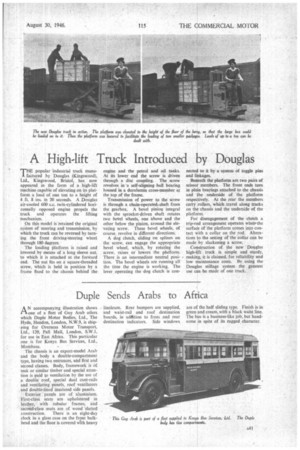A High-lift Truck Introduced by Douglas
Page 43

If you've noticed an error in this article please click here to report it so we can fix it.
THE popular industrial truck manufactured by Douglas (Kingswood), Ltd., Kingswood, Bristol, has now appeared in the form of a high-lift machine capable of elevating on its platform a load of one ton to a height of 4 ft. 8 ins. in 20 seconds. A Douglas air-cooled 600 c.c. twin-cylindered horizontally opposed engine propels the truck and operates the lifting mechanism.
On this model is retained the original system of steering and transmission, by which the truck can be reversed by turning the front driving-steering wheel through 180 dagrees.
The loading platform is raised and lowered by means of a long sleeve nut, to which it is attached at the forward end. The nut fits on a square-threaded screw, which is held in position by a frame fixed to the chassis behind the engine and the petrol and oil tanks. At its lower end the screw is driven through a disc coupling. The screw revolves in 'a self-aligning bail bearing housed in a duralumin cross-member at the top of the frame.
Transmission of power to the screw is through a chain-operated ,shaft from the gearbox. A bevel pinion integral with the sprocket-driven shaft rotates two bevel wheels, one above and the other below the pinion, around the elevating screw. These bevel wheels, of course, revolve in different directions.
A dog clutch, sliding on splines on the screw, can engage the appropriate bevel wheel, which, by rotating the screw, raises or lowers the platform. There is an intermediate neutral position. The bevel wheels are running all the time the engine is working. The lever operating the dog clutch is con
nected to it by a system of toggle pins and linkages.
Beneath the platform are two pairs of scissor members. The front ends turn in plain bearings attached to the chassis and the underside of the platform respectively. At the rear the members carry .rollers, which travel along tracks on the chassis and the underside of the platform.
For disengagement of the clutch a trip-rod arrangement operates when the surface of the platform comes into contact with a collar on the rod. Alterations to the setting of the collar can be made by slackening a screw.
Construction of the new Douglas high-lift truck is simple and sturdy,
• making, it is claimed, for reliability and low maintenance costs. By using the Douglas stillage system the greatest use can be made of one truck,




































































